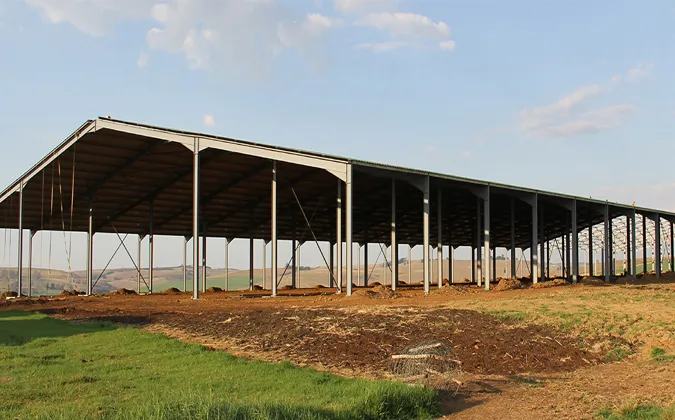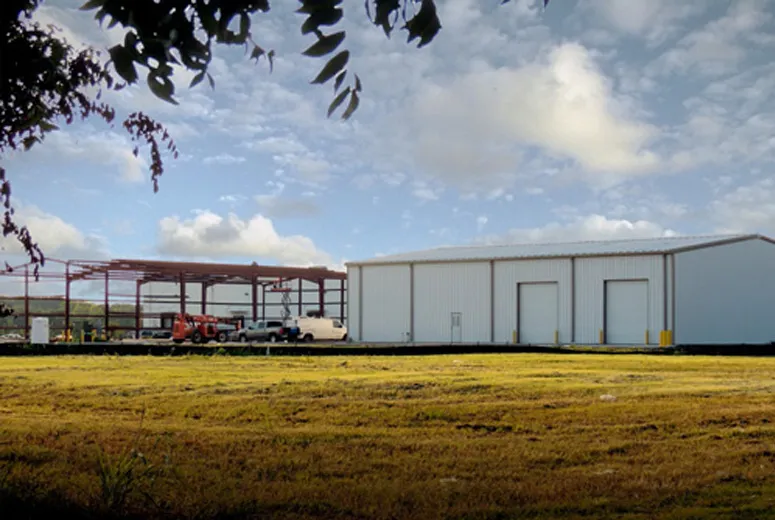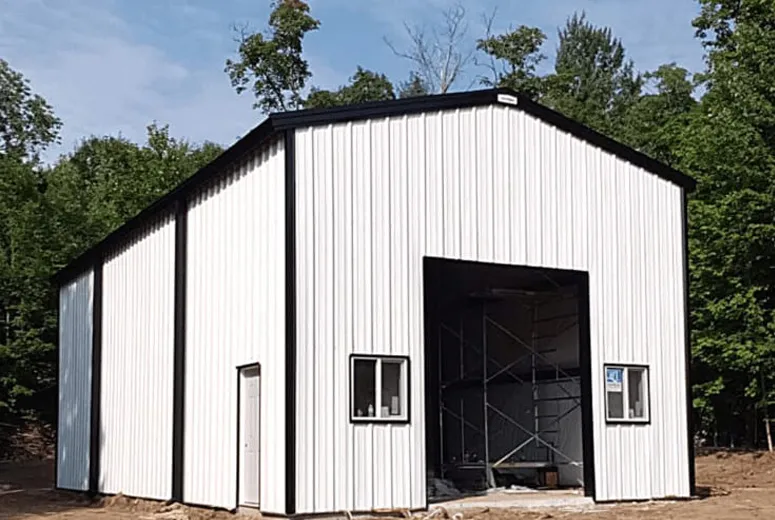Shed steel metal buildings are versatile, durable, and cost-effective structures designed for a wide range of applications. These big metal sheds are primarily used for storage, workshops, and other industrial metal shed purposes, and they offer significant advantages over traditional construction methods. Here are some key features of shed steel metal buildings.
1. Durability and Strength
One of the standout features of these galvanized metal sheds for sale is their exceptional durability. Steel is resistant to weather, pests, and decay, ensuring that the building lasts for years with minimal maintenance. Unlike wood, steel does not warp, crack, or rot, making it an ideal choice for structures exposed to harsh environmental conditions.
2. Customizable Design
Shed steel metal buildings can be customized to suit specific needs. Whether you need a small storage shed or a larger industrial space, steel buildings can be designed in various sizes and configurations. Additionally, the layout can include features like large doors for equipment access, insulation for temperature control, or windows for natural light.
3. Quick Construction
Steel metal buildings are prefabricated in sections, allowing for faster construction compared to traditional buildings. These pre-engineered kits come with all the necessary components and can be quickly assembled on-site, reducing labor costs and construction time.
4. Low Maintenance
Steel buildings require minimal maintenance compared to wooden or brick structures. They are resistant to mold, mildew, and insect damage, which significantly lowers long-term upkeep costs. Regular inspections and occasional cleaning are typically all that is needed to keep the building in excellent condition.
5. Cost-Effectiveness
Shed steel metal buildings are often more affordable than conventional buildings. The cost of materials and labor is lower, and the long-term savings on maintenance and repairs further enhance their cost-effectiveness.
In conclusion, shed steel metal buildings offer numerous benefits, including durability, customization, quick construction, low maintenance, and cost-effectiveness. These features make them an excellent choice for various agricultural, industrial, and commercial applications.
What are the disadvantages of a metal shed?
While metal sheds offer numerous advantages such as durability, strength, and low maintenance, they also come with certain drawbacks. It’s important to consider these disadvantages before deciding if a steel shed metal building is the right choice for your needs.
1. Susceptibility to Rust and Corrosion
One of the primary concerns with metal sheds is their potential to rust, especially in areas with high humidity or frequent rainfall. Over time, if the metal is not properly treated with anti-corrosion coatings or if the protective layers wear off, the shed may suffer from rust and deterioration. This can compromise the structure's integrity, leading to expensive repairs.
2. Heat Retention
Metal sheds tend to absorb and retain heat, making them very hot during the summer months. Without proper insulation or ventilation, the interior temperature of the shed can become uncomfortably high, which can be problematic for storing temperature-sensitive items or for people working inside. Excessive heat buildup can also lead to expansion and contraction of the metal, potentially causing damage.
3. Noise
Another disadvantage of metal sheds is their noise level. During heavy rainfall, hail, or strong winds, the sound of water or debris hitting the metal can be loud and disruptive. This can be particularly bothersome if the shed is used for activities that require concentration or if it's located near residential areas.
4. Limited Aesthetic Appeal
While metal sheds are functional, they may not have the same aesthetic appeal as wooden or brick structures. If you're looking for a shed that complements the design of your home or garden, a metal shed may not provide the visual appeal you desire.
5. Potential for Denting
Metal sheds, especially those made from thinner gauge steel, can be prone to denting if struck by heavy objects or debris. While this may not affect the structural integrity, it can impact the appearance of the shed and may require repairs.
In conclusion, while metal sheds are strong, low-maintenance options, they have some disadvantages, including susceptibility to rust, heat retention, noise, limited aesthetics, and potential for denting. Careful consideration of these factors is essential to determine if a metal shed is suitable for your needs.
What is the Meaning of Steel Building?
A steel building refers to a structure primarily made from steel, a material known for its strength, durability, and versatility. These buildings are designed to serve various purposes, from industrial and commercial use to residential and agricultural applications. Steel buildings are often chosen for their efficiency, cost-effectiveness, and sustainability.
Core Features
Steel buildings are typically constructed using steel framing, which forms the skeleton of the structure. The framing is then covered with steel panels or other materials depending on the building's intended use. Common types of steel buildings include warehouses, factories, workshops, garages, and even modern homes. Steel’s ability to support large spans without requiring internal support columns makes it ideal for creating wide, open spaces.
Advantages
One of the key advantages of steel buildings is their strength-to-weight ratio. Steel is incredibly strong yet lightweight, allowing for faster and more efficient construction. It is also resistant to pests, fire, and extreme weather, making it a durable choice for various environments. Additionally, steel buildings are easy to customize, offering flexibility in size, design, and functionality.
Sustainability
Steel is a recyclable material, which makes steel buildings an environmentally friendly option. The prefabrication process used for most steel buildings reduces waste, further contributing to sustainability.
In conclusion, a steel building is a versatile and durable structure made predominantly from steel. Its strength, cost-efficiency, and eco-friendly characteristics make it a popular choice across a wide range of industries and applications.
Where Size Meets Strength in Steel
When storage demands grow beyond the limits of conventional solutions, a big metal shed becomes more than a building—it becomes a necessity. At Hebei HongJi Shunda Steel Structure Engineering Co., Ltd., we’ve spent over two decades perfecting steel structures that deliver not just scale, but resilience, adaptability, and long-term value. Whether you're expanding agricultural capacity, building a fleet maintenance bay, or protecting large-scale equipment from the elements, our big metal sheds are designed to meet the challenge.
What sets these structures apart is not just their impressive size, but their uncompromising structural integrity. Built with high-tensile galvanized steel, each shed is engineered to resist rust, fire, pests, and extreme weather conditions. Unlike wooden alternatives that require regular maintenance and struggle under heavy loads or high humidity, our steel sheds remain strong and stable year after year, even in the harshest environments.
Customers searching for big metal sheds for sale often come with specific goals in mind—whether it’s housing tractors and harvesters on a farm, storing bulk inventory for a growing business, or creating a personal auto workshop with overhead crane capacity. That’s why we offer fully customizable layouts. From oversized roller doors for easy vehicle access to insulated wall panels that support temperature-sensitive operations, every component can be configured to match your workflow and operational needs.
Need extra ventilation for livestock housing? Prefer skylight panels for natural light? Want internal partition walls to create multiple zones under one roof? Our design team can incorporate all these elements and more. We even offer prefabricated kits that can be shipped and installed quickly, reducing downtime and construction costs.
With over 52,000 square meters of manufacturing capacity and a dedicated construction team, Hebei HongJi Shunda ensures that each project is executed with precision and care. Our reputation for delivering high-performance steel sheds across agriculture, industry, and logistics is built on the durability and functionality of our buildings.
A big metal shed is more than just oversized storage—it’s a long-term investment in your productivity and protection. When strength, size, and service matter, our steel solutions stand taller than the rest.
What Makes an Insulated Metal Shed Special?
Why are more people upgrading to an insulated metal shed rather than settling for a standard build? The answer lies in a powerful mix of comfort, protection, and year-round functionality. As demands for multi-use spaces grow, these upgraded steel structures are quickly becoming the preferred choice for those who want more than just a basic shelter.
At Hebei HongJi Shunda Steel Structure Engineering Co., Ltd., we specialize in constructing insulated metal sheds that go far beyond simple storage. Whether you're converting it into a workshop, hobby room, craft studio, or small business hub, insulation plays a vital role in turning a cold, drafty box into a comfortable, usable space. By incorporating high-density insulation materials into the walls and roof—such as polyurethane foam or fiberglass—we drastically reduce temperature fluctuation, which helps regulate interior climate, minimize condensation, and keep out excess noise.
This stable environment is ideal for anyone storing sensitive materials, operating machinery, or working extended hours inside. Paints, tools, electronics, and textiles all benefit from protection against moisture, mold, and freezing or overheating. In cold climates, insulation prevents frost buildup; in hotter regions, it reflects radiant heat—both of which extend the life of everything inside, including the building itself.
Buyers exploring insulated metal sheds for sale are increasingly drawn by their cost-efficiency over time. Proper insulation significantly lowers heating and cooling expenses, especially when paired with sealed windows and insulated roll-up or hinged doors. That means you get the comfort of a small residential structure with the rugged durability of industrial-grade steel—strong enough to withstand wind, rain, and snow, yet refined enough to serve as a year-round workspace.
Want to use your shed as a home gym, remote office, or creative studio? With added ventilation systems, lighting, and interior finishes, our insulated sheds can be fully outfitted to feel like a professional space. We offer fully customizable solutions, tailored to your specific needs and environment, all manufactured under the strict quality control of our 52,000-square-meter facility.
So, an insulated metal shed isn’t just a place to store—it’s a place to work, build, and grow. With insulation, steel, and smart design working together, your shed becomes a four-season solution built for comfort and performance.
The Ease of Pre Built Metal Sheds
When it comes to adding durable, functional space quickly, few options compare to the convenience of a pre built metal shed. As more property owners, schools, and business operators seek fast, dependable solutions, these prefabricated structures are becoming the go-to choice for those who value time, reliability, and quality.
Traditional construction projects often come with a long list of uncertainties—weather delays, rising material costs, fluctuating labor availability, and on-site coordination. Even a small shed can take weeks to plan and assemble from the ground up. But pre built metal sheds flip that model on its head. At Hebei HongJi Shunda Steel Structure Engineering Co., Ltd., we manufacture these units in controlled environments using precision engineering techniques. Every bolt, panel, and weld is completed before the shed ever leaves our 52,000-square-meter facility, which means it arrives at your site ready for immediate use.
This time-saving approach doesn’t compromise on quality. We use the same robust materials—galvanized steel frames, reinforced paneling, corrosion-resistant coatings—that go into our custom-designed buildings. In fact, because they’re assembled in factory conditions, prebuilt metal sheds often feature higher structural consistency and fewer installation errors compared to site-built alternatives. Their sealed seams, uniform joints, and rigid construction help reduce maintenance and improve lifespan, particularly in high-use or outdoor environments.
The real value comes in the speed and simplicity of deployment. Whether you need a storage shed for landscaping equipment, a secure shelter for school sports gear, or a temporary utility room on a construction site, these sheds are delivered fully assembled and ready for action. Most units can be placed directly on a level foundation or concrete slab with minimal site prep, allowing you to bypass traditional permitting and reduce total project costs.
Additionally, we offer a range of sizes and configurations—from compact tool sheds to oversized industrial units. Custom options like vents, windows, shelving, and insulated panels can be integrated into the design before delivery, giving you a tailored solution without the drawn-out timeline of custom builds.
If speed, efficiency, and durability are your top concerns, a pre built metal shed offers a smart investment. It’s more than just a building—it’s an instant upgrade to your space, delivered with confidence and built to last.











